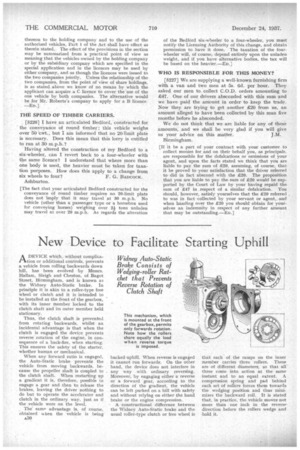New Device to Facilitate Starting Uphill
Page 18

If you've noticed an error in this article please click here to report it so we can fix it.
A DEVICE which, without complicarItion or additional controls, prevents a vehicle from rolling backwards down hill, has • been evolved by Messrs. Hallam, Sleigh and Cheston, of Bagot Street, Birmingham, and is known as the Widney Auto-Static brake. In principle it is akin to a roller-type free wheel or clutch and it is intended to be installed at the front of the gearbox, with its inner member locked to the clutch shaft and its outer member held stationary.
Thus, the clutch shaft is prevented from rotating backwards, whilst an incidental advantage is that when the clutch is engaged the device prevents reverse rotation of the engine, in consequence of a back-fire, when starting. This ensures the safety of the starter, whether human or mechanical.
When any forward ratio is engaged, the Auto-Static brake prevents the vehicle from moving backwards, because the propeller shaft is coupled to the clutch shaft. When restarting up a gradient it is, therefore, possible to engage a gear and .then to release the brakes, leaving the driver nothing to do but to operate the accelerator and clutch in the ordinary way, just as if the vehicle were on the level.
The' same advantage is, of course, obtained %%hen the vehicle is being A30
backed uphill, When reverse is engaged it cannot run forwards. On the other hand, the device does not interfere in any way with ordinary reversing. Moreover, by engaging either a reverse or a forward gear, according to the direction of the gradient, the vehicle can he left parked on a hill with safety and without relying on either the hand brake or the engine compression.
A constructional difference between the Widney Auto-Static brake and the usual roller-type clutch or free wheel is that each of the ramps on the inner member carries three rollers. These are of different diameters, so that a11. three come into action at the same instant and to an equal extent. A compression spring and pad behind each set of rollers forces them towards the wedging position and thus minimizes the backward roll. It is stated that, in practice, the vehicle moves not more than one inch in the reverse. direction before tbe rollers wedge and hold it.


























